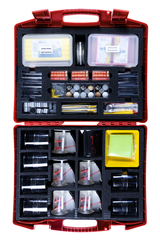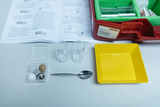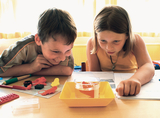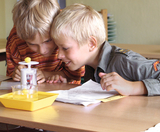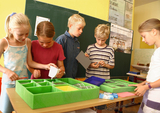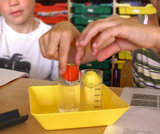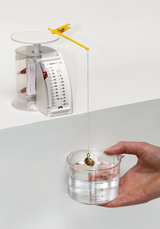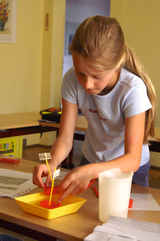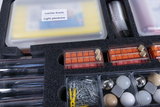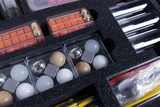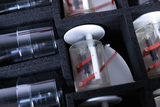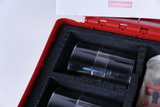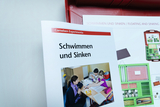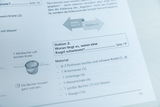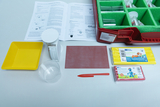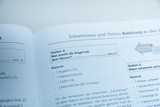Students kit Floating and sinking
This kit allows children to observe the essential phenomena of floating and sinking.
The key experiments are based on “boats” that the children can make from two sorts of plasticine: One sort is lighter than water and therefore floats whereas the other one is heavier than water and usually sinks unless it is moulded into a shape that can float.
The box also contains balls and a cube made of materials used in the building of ships and boats: wood, steel, aluminium and plastic.
Scales can be used to determine the apparent reduction in weight experienced by a body when it is immersed in water.
All phenomena are examined separately in comprehensible experiments:
The carrying capacity of ships, the displacement of a body suspended in water, the buoyancy and the surface tension of water.
Teacher’s manual ‘Experiments in workstations: Floating and sinking’
With copy templates covering 14 workstations.
Age 9-10
Materials for up to 14 workstations (for 28 children at least)
Technical specifications
Size of kit: 540 x 450 x 150 mm
The main goal of this tutorial is the ability to divide the dough into equal portions in the box.
The children fill mini cups with water and modeling clay of different weights. You watch what happens to the putty.
The children form balls of different sizes from the two types of play dough and drop them into the water after they have determined the mass with the scales.
The learning outcome from working on station 3 lies in the realization that hardly any ship floats anymore because the material from which it was built also does. In addition, the children learn to name the materials and can – in a simple context – give examples of ships and boats.
Here the children find out that all balls of the same size displace the same amount of water, regardless of their mass!
The children can easily see the reason why the amounts of clay must be the same, even if they reason with terms like "fair". Here, in conversations, there is a good opportunity to propaedeutically discuss the conditions under which scientific experiments become meaningful.
The children realize that the ship is already displacing water when you put it in the water and even more when you load it.
The children like to deal with sinking and find at least the possibilities mentioned in the "solution hiding place". Some of the terms mentioned there are new to many students (leak, capsize, fill with water).
If we hang the two weights in the water on the "fishing rod" - what will happen? Will there be a difference?
We will shortly provide you with a description of the experiment at this point.
This beetle's "trick" is to use the surface tension of water. As the children find out in their experiments with thin discs of different sizes made of "heavy" modeling clay, we also succeed in this "trick".
We will shortly provide you with a description of the experiment at this point.
We will shortly provide you with a description of the experiment at this point.
We will shortly provide you with a description of the experiment at this point.
The children form a portion of modeling clay – which is a low cylinder at the beginning – first into a cube, then into a/one... and keep putting it into the water - no body floats. Only the hollow, bowl-shaped body floats.
We will shortly provide you with a description of the experiment at this point.
- 1 × Paper clips (100 pcs.)
- 12 × Beaker, plastic 250 ml, graduated
- 2 × Plastic box 140/50/35 mm
- 1 × Cleaning cloth
- 5 × Rapid scale, 100 g
- 1 × Foam insert 1 for 31900, 505x355x45 mm
- 1 × Foam insert 2 for 31900, 515x370x95 mm
- 8 × Pastry cutter, aluminium,25 mm
- 1 × Pack. of light plasticine
- 12 × Mat, 200x120 mm
- 1 × Pack, of heavy plasticine
- 12 × Plastic knife
- 3 × Aluminium cube 18x18x18mm
- 4 × Plastic box 60x60x30 mm
- 1 × Tray 510x360x20 mm
- 12 × Dish, plastic, yellow 150x140x35mm
- 3 × Plastic ball, PP, 25 mm Ø(density=0,9)
- 3 × Plastic ball, POM, 25 mmØ(density=1,1)
- 3 × Ball, steel, 25 mmØ
- 2 ×
- 12 ×
- 3 × Metal spoon, 138 mm
- 1 × Storing diagram,int.vers.
- 6 × Graduated cylinder, 60 ml
- 6 × Set of weights, 2x10g/10x1g
- 5 × Fishing rod with string and hook
- 11 × Beaker, plastic 30 ml
- 3 × Plastic body with hook, 25x25x11 mm, 10 g
- 1 × Plastic case ca.540x450x150 mm
- 3 × Wooden ball 25 mm Ø
- 1 × Displacement vessel 400ml

